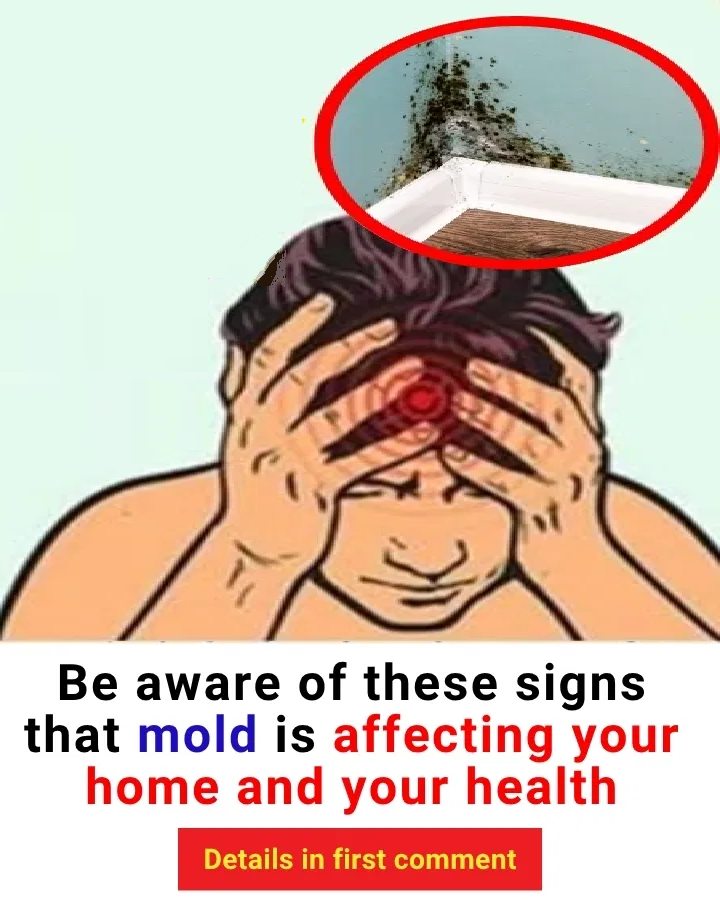You should have known this sooner.
⚠️ Be Aware of These Signs That Mold Is Affecting Your Home and Your Health
Mold is a type of fungus that thrives in damp, humid environments. While it might not always be visible, it can seriously affect your health, especially if left untreated in your living space.
🏠 Signs of Mold in Your Home
1. Musty or Damp Odor
- A persistent earthy or moldy smell, especially in basements, bathrooms, or closets.
2. Visible Mold Growth
- Black, green, white, or gray patches on walls, ceilings, tiles, or furniture.
3. Water Damage or Stains
- Brown or yellow water stains on ceilings or walls often indicate mold behind the surface.
4. Peeling Paint or Wallpaper
- Moisture under the paint can cause bubbles, cracks, or peeling, a sign of hidden mold.
5. Condensation
- Frequent fogging on windows or surfaces shows high indoor humidity—ideal for mold.
6. Warped Walls or Flooring
- Excess moisture can cause wood to swell, warp, or rot, allowing mold to grow underneath.
🧍♀️ Signs Mold Is Affecting Your Health
1. Persistent Cough or Sneezing
- Mold spores irritate the respiratory system, causing cold-like symptoms that don’t go away.
2. Allergic Reactions
- Runny nose, watery eyes, rashes, or headaches, especially when inside the home.
3. Asthma Flare-Ups
- Mold can trigger or worsen asthma symptoms: wheezing, tight chest, or shortness of breath.
4. Chronic Fatigue or Brain Fog
- Mold exposure may lead to tiredness, poor concentration, or mood swings.
5. Sinus Infections
- Repeated sinus issues or inflammation may be linked to mold inhalation.
6. Skin Irritation
- Itchy skin or unexplained rashes can result from direct or airborne mold contact.
Note: Children, the elderly, and those with weakened immune systems are especially vulnerable.
🧼 How to Eliminate Mold From Your Home
✅ 1. Identify and Remove the Source of Moisture
- Fix any leaks in roofs, pipes, or appliances.
- Improve ventilation in damp areas (use exhaust fans in bathrooms and kitchens).
✅ 2. Use Natural Cleaning Solutions
- White vinegar: Spray undiluted on moldy surfaces. Let sit for 1 hour, then scrub.
- Baking soda: Mix 1 tsp with water in a spray bottle. Use for mild mold.
- Hydrogen peroxide (3%): Effective for porous surfaces like fabric or drywall.
✅ 3. Remove and Replace
- Severely damaged items (carpets, ceiling tiles, drywall) may need to be discarded.
✅ 4. Use a Dehumidifier
- Keep indoor humidity between 30–50% to prevent mold growth.
✅ 5. Improve Air Circulation
- Open windows regularly and avoid drying clothes indoors.
✅ 6. Use Mold-Resistant Products
- Choose mold-resistant paints, drywall, and insulation for renovations or repairs.
🛑 When to Call a Professional
- If mold covers an area larger than 10 square feet.
- If mold is growing in air ducts or HVAC systems.
- If you or your family experience severe health symptoms.
